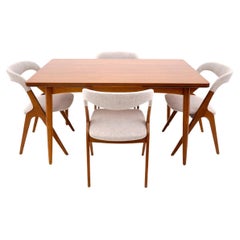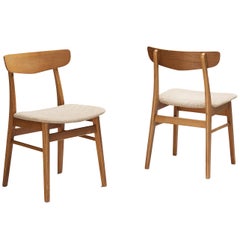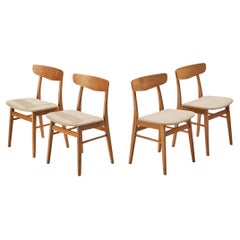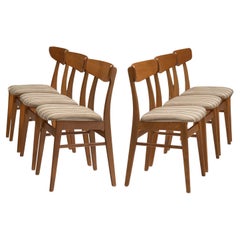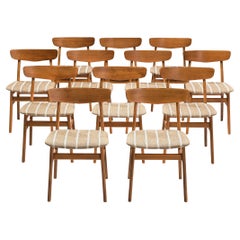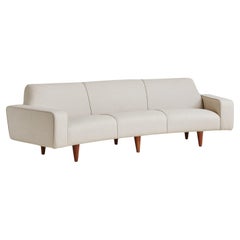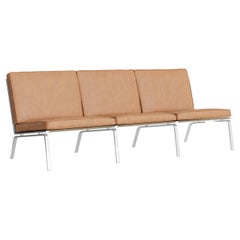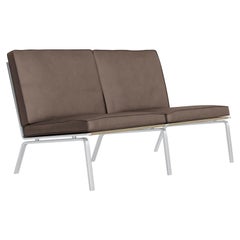1960s Danish Furniture
Mid-20th Century Danish Scandinavian Modern Dining Room Sets
Teak
Vintage 1960s Danish Scandinavian Modern Dining Room Chairs
Fabric, Beech, Teak
Vintage 1960s Danish Scandinavian Modern Dining Room Chairs
Fabric, Beech, Teak
Vintage 1960s Danish Scandinavian Modern Dining Room Chairs
Fabric, Beech, Teak
Vintage 1960s Danish Scandinavian Modern Dining Room Chairs
Fabric, Beech, Teak
Vintage 1960s Danish Mid-Century Modern Cabinets
Oak
Vintage 1960s Danish Scandinavian Modern Sofas
Upholstery, Wood
21st Century and Contemporary Danish Organic Modern Sofas
Stainless Steel
21st Century and Contemporary Danish Organic Modern Sofas
Stainless Steel
21st Century and Contemporary Danish Organic Modern Sofas
Stainless Steel
21st Century and Contemporary Danish Organic Modern Sofas
Stainless Steel
21st Century and Contemporary Danish Organic Modern Lounge Chairs
Stainless Steel
21st Century and Contemporary Danish Organic Modern Lounge Chairs
Stainless Steel
Vintage 1960s Danish Mid-Century Modern End Tables
Steel
Vintage 1960s Danish Mid-Century Modern Cabinets
Teak
Vintage 1960s Danish Scandinavian Modern Table Lamps
Stoneware
Vintage 1960s Danish Scandinavian Modern Table Lamps
Stoneware
20th Century Danish Mid-Century Modern Barware
Plastic, Teak
Vintage 1960s Danish Table Lamps
Silk, Teak
Vintage 1960s Danish Scandinavian Modern Wall Lights and Sconces
Stoneware
Vintage 1960s Danish Scandinavian Modern Platters and Serveware
Glass, Teak
Vintage 1960s Danish Scandinavian Modern Sofas
Teak
Vintage 1960s Danish Scandinavian Modern Chandeliers and Pendants
Metal, Brass
Vintage 1960s Danish Mid-Century Modern Sideboards
Rosewood
Vintage 1960s Danish Mid-Century Modern Sideboards
Rosewood
20th Century Danish Mid-Century Modern Serving Pieces
Teak
20th Century Danish Mid-Century Modern Tobacco Accessories
Teak
Vintage 1960s French Mid-Century Modern Lounge Chairs
Fabric, Teak
Vintage 1960s Danish Scandinavian Modern Armchairs
Velvet, Beech
Vintage 1960s Danish Chairs
Chrome
Vintage 1960s Danish Mid-Century Modern Desks and Writing Tables
Chrome
Mid-20th Century Danish Mid-Century Modern Side Tables
Teak
Mid-20th Century Danish Scandinavian Modern Sofas
Upholstery, Teak
Vintage 1960s Danish Mid-Century Modern Sideboards
Rosewood
Vintage 1960s Danish Scandinavian Modern Cabinets
Teak
Vintage 1960s Danish Scandinavian Modern Armchairs
Brass
Vintage 1960s Danish Scandinavian Modern Armchairs
Fabric, Beech
Vintage 1960s Danish Scandinavian Modern Armchairs
Velvet, Ash
20th Century Danish Scandinavian Modern Tableware
Teak
Mid-20th Century Danish Mid-Century Modern Dining Room Tables
Teak
Vintage 1960s Danish Scandinavian Modern Armchairs
Wool, Oak
Mid-20th Century Danish Mid-Century Modern Side Tables
Wood
Vintage 1960s Danish Scandinavian Modern Armchairs
Wool, Oak
Vintage 1960s Danish Scandinavian Modern Candlesticks
Ceramic
Vintage 1960s Danish Scandinavian Modern Carts and Bar Carts
Laminate
Vintage 1960s Danish Scandinavian Modern Footstools
Leather, Beech
Vintage 1960s Danish Scandinavian Modern Armchairs
Fabric, Teak
20th Century Armchairs
Leather
Vintage 1960s Danish Brutalist Side Tables
Oak
Mid-20th Century Danish Scandinavian Modern Sideboards
Teak
Mid-20th Century Danish Scandinavian Modern Sideboards
Teak
Vintage 1960s Mid-Century Modern Desks and Writing Tables
Steel
Vintage 1960s Danish Mid-Century Modern Armchairs
Cherry, Bouclé
Vintage 1960s Danish Scandinavian Modern Armchairs
Velvet, Ash
Vintage 1960s Danish Scandinavian Modern Armchairs
Velvet, Beech
Vintage 1960s Danish Scandinavian Modern Sofas
Velvet, Beech
Vintage 1960s Danish Scandinavian Modern Armchairs
Velvet, Beech
Vintage 1960s Danish Scandinavian Modern Sofas
Velvet, Beech
Vintage 1960s Danish Scandinavian Modern Armchairs
Wool, Teak
Vintage 1960s Danish Scandinavian Modern Sofas
Velvet, Beech
- 1
- ...
1960s Danish Furniture For Sale on 1stDibs
How Much is a 1960s Danish Furniture?
- 1stDibs ExpertFebruary 13, 2023Furniture from the 1960s is often called mid-century modern. This style emphasizes the importance of good design that looks attractive and performs its function well. Notable mid-century modern designers include Eero Saarinen, George Nelson, Florence Knoll and Charles and Ray Eames. On 1stDibs, shop a selection of mid-century modern furniture.
- 1stDibs ExpertMarch 3, 2023To tell if furniture is Danish, locate the stamp or label with the maker's name. Refer to trusted online resources to find out if the manufacturer or artisan's workshops are in Denmark. If you have difficulty locating the name of the maker, consult a certified appraiser or experienced antiques dealer for assistance identifying the piece. On 1stDibs, shop a collection of Danish furniture.
- Why is Danish furniture so good?1 Answer1stDibs ExpertJune 15, 2023Vintage Danish furniture is so good because its design was founded on centuries-old beliefs in both quality craftsmanship and the ideal that beauty should enhance even the humblest accessories of daily life. Mid-century Danish furniture took off in the United States after the Second World War, when Scandinavia’s simple, curvilinear wooden furniture, home goods and textiles suddenly seemed the perfect foil for glass-and-steel skyscrapers. The Danes excelled at chairs. Hans Wegner and Arne Jacobsen were exemplars of the country’s facility with wood, particularly teak. Wegner created such iconic pieces as the Round chair and the Wishbone chair. Find vintage and antique Danish furniture on 1stDibs.
- 1stDibs ExpertFebruary 1, 2024Generally, 1960s-style furniture is called mid-century modern. The style, which emerged primarily in the years following World War II, is characterized by pieces that were conceived and made in an energetic, optimistic spirit by creators who believed that good design was an essential part of good living. Some of the most notable furniture designers of the time include Charles and Ray Eames, Arne Jacobsen, Eero Saarinen and Hans J. Wegner. On 1stDibs, shop a variety of mid-century modern furniture.
- What was worn in the 1960s?1 Answer1stDibs ExpertFebruary 22, 2021Fashion in the 1960s progressed toward a more casual look for men and for women during the decade. For women, the skirt suits of the 1950s prevailed during the early ‘60s and eventually miniskirts came along. Late-1960s fashion included ponchos, peace signs, chain belts, puffed “bubble” sleeves, frayed bell-bottom jeans for men and women, tie-dyed shirts, work shirts, sandals, headbands and moccasins.
- Were there watches in the 1960s?1 Answer1stDibs ExpertFebruary 13, 2023Yes, there were watches in the 1960s. The first recorded wristwatch dates back to 1868, when Patek Philippe, a watchmaker founded in Geneva in 1839 by Polish expats Antoni Patek and Franciszek Czapek, designed a timepiece for Countess Koscowicz of Hungary. Shop a collection of vintage watches from some of the world’s top sellers on 1stDibs.
- What is a caftan from the 1960s?1 Answer1stDibs ExpertFebruary 13, 2023A caftan from the 1960s or any other era refers to a long ankle-length variation on a robe or a tunic. Caftans, which are sometimes referred to as kaftans, feature full sleeves and usually have a deep, open neck. While these garments can be made from any fabric, most caftans are made of wool, silk or cotton. Find a selection of caftans from top fashion boutiques around the world on 1stDibs.
- What is Danish modern furniture?1 Answer1stDibs ExpertFebruary 13, 2024Danish modern furniture is the term for a style of furniture that emerged during the 1930s through the innovation of designers from Denmark. It is a subset of Scandinavian modern furniture, the warmest and most organic iteration of modernist design. The work of the designers associated with vintage Scandinavian modern furniture was founded on centuries-old beliefs in both quality craftsmanship and the ideal that beauty should enhance even the humblest accessories of daily life. Some notable Danish modern designers include Hans J. Wegner, Kaare Klint, Arne Jacobsen, Finn Juhl, Arne Vodder and Verner Panton. Shop a range of Danish modern furniture on 1stDibs.
- 1stDibs ExpertNovember 4, 2024To identify Danish furniture, search inconspicuous areas of your piece for a maker's mark. Upon locating one, use trusted online resources to learn about the maker and determine if your piece originated from Denmark or a Danish designer. Some well-known Danish makers include Hans Wegner, Arne Jacobsen, Kaare Klimt, Børge Mogensen, Finn Juhl, HAY, Poul Kjærholm, Vernon Panton and Fritz Hansen. Shop a large selection of Danish furniture on 1stDibs.
- What did men wear in the 1960s?1 Answer1stDibs ExpertApril 26, 2024What men wore in the 1960s varied over the course of the decade. At the start of the ’60s, when the Mod style was all the rage, men often sported boxy Italian-style suits with tight-fitting trousers for work and dressier occasions and polo shirts and turtlenecks paired with fitted trousers for casual dress. As the decade progressed, the Peacock Revolution occurred, with menswear becoming flashier with bright colors and bold prints. Fedoras and trilby hats were common in the early ’60s, but by the start of the 1970s, hats for men were much less common, marking a major departure from the style conventions of the 1930s, ’40s and ’50s. Explore an assortment of 1960s men's apparel and accessories on 1stDibs.
- 1stDibs ExpertFebruary 21, 2024The dresses they wore in the 1960s varied depending on the time of day and the occasion. For everyday wear, many women opted for simply tailored frocks called shift dresses. They often featured bold geometric prints in eye-catching colors. In the evening, women tended to opt for gowns with plunging necklines, fitted waists and flowing full skirts. On 1stDibs, shop a diverse assortment of vintage dresses from the 1960s.
- 1stDibs ExpertApril 5, 2022To tell if a dress is from the 1960s or 1970s, first look for a label. You may be able to determine the approximate date of the dress simply by researching the designer using reputable online sources. Also, check the zippers. Dresses from the 1960s will usually have metal or nylon zippers. Ones from the 1970s are more likely to be plastic. You'll find a large selection of vintage dresses on 1stDibs.
- 1stDibs ExpertSeptember 25, 2019
Danish and Swedish design share many tenets, including an emphasis on simplicity and functionality. Danish furniture generally expresses these ideas through new industrial technologies, while Swedish products are minimalist and stress clean lines.
- 1stDibs ExpertNovember 26, 2024To identify Danish teak furniture, look for stamps, labels and tags that bear a maker's mark. You can consult trusted online resources to determine who produced your piece and whether it is a Danish maker. From there, research the company, workshop or artisan to find out if it produced pieces out of teak wood and search online catalogues to see if you can find your item and learn more about its materials. Knowing the characteristics of teak wood can also be helpful. It often has a smooth, straight grain and tends to be dense. Colors vary, but fine-quality pieces often have a golden-brown hue. When in doubt about your furniture, have a certified appraiser or experienced antique dealer assist you. Shop a selection of Danish teak furniture on 1stDibs.
- 1stDibs ExpertApril 5, 2022Go-go boots were fashionable in the late 1960s through the 1970s. A calf-length to knee-length boot became synonymous with 1960s and 1970s fashion and is still highly coveted today by fashion enthusiasts. Shop a wide range of vintage go-go boots on 1stDibs.
- 1stDibs ExpertFebruary 21, 2024Who the most famous fashion designer of the 1960s was is open to debate. Many designers helped define the looks of the decade, each influencing style in their own way. Among these notable designers were Mary Quant, André Courrèges, Pierre Cardin, Yves Saint Laurent, Bonnie Cashin, Hubert de Givenchy, Emilio Pucci, Paco Rabanne and Ossie Clark. On 1stDibs, shop a variety of vintage apparel and accessories from the 1960s.
- 1stDibs ExpertSeptember 27, 2024What the dress style was called in the 1960s varied, as there were several types of dresses that were fashionable during the decade. At the start of the 1960s, many women wore swing dresses featuring fitted bodices and full skirts. Collared, button-up belted dresses called shirtwaist dresses were also popular, as were loose-fitting, flowy shift dresses. By the late 1960s, new styles emerged, such as flared, flowing tent dresses, sleeveless jumpers usually styled over sweaters and blouses and drop-waist dresses, which had their waist seams at the hips rather than the natural waist. Find a variety of 1960s dresses and other vintage dresses on 1stDibs.
- What is ’70s furniture called?1 Answer1stDibs ExpertSeptember 23, 2024What ’70s furniture is called depends on its style. Generally, pieces from this decade can be called vintage furniture. However, pieces with certain stylistic characteristics have other names. For example, some 1970s furniture is mid-century modern. The style, which emerged primarily in the years following World War II, was developed in an energetic, optimistic spirit by creators who believed that good design was an essential part of good living. On 1stDibs, shop a variety of 1970s furniture.
- What is 1970s furniture called?1 Answer1stDibs ExpertMarch 15, 2024What 1970s furniture is called varies. Generally, you may see pieces produced during the decade classified as "vintage" or "retro" furniture. During the 1970s, some makers continued to produce furniture that boasted the characteristics of mid-century modern works. The disco era yielded furnishings with organic, often rounded shapes, unadorned silhouettes, clean lines and a mix of materials. The showy leather furniture of the 1970s, which was both sexy and comfortable, is seeing a resurgence in today’s homes. Shop a wide variety of vintage 1970s furniture on 1stDibs.
- What is 1950s furniture called?1 Answer1stDibs ExpertSeptember 23, 20241950s furniture is called vintage furniture. Some pieces produced during this period may be considered mid-century modern based on their characteristics. Mid-century modern design refers to the variety of modernism that rose to prominence in the 1940s and ’50s. It displays many of the characteristics of the earlier versions of modernism, including simple forms and a focus on functionality. Other traits common in mid-century modern furniture include unadorned silhouettes, clean lines and mixed materials, emphasizing wood, wool, steel and plastic. On 1stDibs, explore a large collection of 1950s furniture.
- 1stDibs ExpertNovember 4, 2024To identify 1800s furniture, first check to see if your piece bears any maker's marks. Should you locate any, researching them using trusted online resources can help you determine the maker and age of your furniture. To determine if unmarked pieces date back to the 19th century, look for tool marks and variations in their carvings and ornamentation. Since 19th-century furniture was handmade, you should expect to find these signs of hand craftsmanship. A piece that shows no marks or inconsistencies in details is likely a contemporary machine-made reproduction. Familiarizing yourself with the characteristics of Rococo, Chippendale, Gothic Revival, neoclassical and other 19th-century styles can also be helpful. If you struggle to make an identification, consider consulting a certified appraiser or knowledgeable antique dealer. On 1stDibs, find a range of 19th-century furniture.
- What is 1920s furniture called?1 Answer1stDibs ExpertNovember 13, 2024What 1920s furniture is called depends on its style. However, the most prominent design style of the decade was Art Deco. The term alone conjures visions of the Roaring Twenties, Machine Age metropolises, vast ocean liners, sleek typography and Prohibition-era hedonism. The iconic movement made an indelible mark on all fields of design throughout the 1920s and ’30s, celebrating society’s growing industrialization with refined elegance and stunning craftsmanship. Art Deco furniture often featured bold geometric lines, floral forms, shimmering mirrored finishes, sleek metal accents, and the use of expensive materials such as shagreen or marble as well as exotic woods such as mahogany, ebony and zebra wood. On 1stDibs, find a diverse assortment of Art Deco furniture.
- 1stDibs ExpertNovember 26, 2024To identify 1930s furniture, first see if you can spot a maker's mark in hidden areas, such as the back, base, inside of drawers or under tabletops and seats. Trusted online resources can help you determine who produced your furniture based on these markings, and from there, you can research more to get a rough idea of how old your item is. A piece's characteristics can also be helpful when dating furniture. Many items made during the 1930s are examples of Art Deco furniture. Art Deco furniture is characterized by geometric patterns and luxurious materials, such as shagreen, marble, mother of pearl, mirrored glass, exotic animal hides and rare woods like mahogany, ebony and zebra wood. A certified appraiser or experienced antique dealer can provide an expert opinion on when your piece was likely made. On 1stDibs, explore a range of 1930s furniture.
